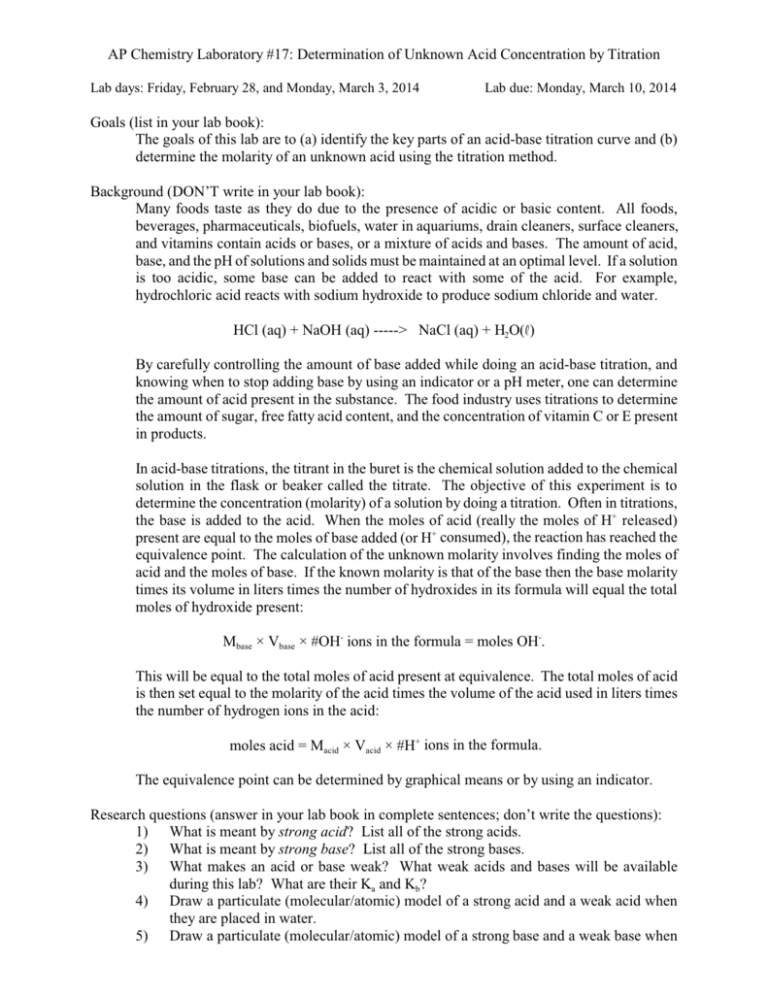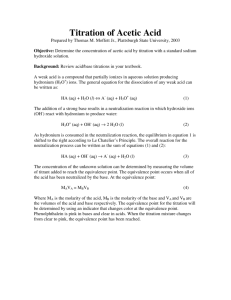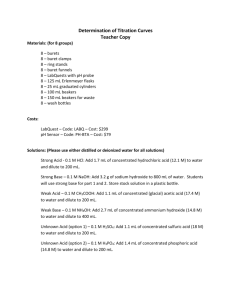
AP Chemistry Laboratory #17: Determination of Unknown Acid Concentration by Titration
Lab days: Friday, February 28, and Monday, March 3, 2014
Lab due: Monday, March 10, 2014
Goals (list in your lab book):
The goals of this lab are to (a) identify the key parts of an acid-base titration curve and (b)
determine the molarity of an unknown acid using the titration method.
Background (DON’T write in your lab book):
Many foods taste as they do due to the presence of acidic or basic content. All foods,
beverages, pharmaceuticals, biofuels, water in aquariums, drain cleaners, surface cleaners,
and vitamins contain acids or bases, or a mixture of acids and bases. The amount of acid,
base, and the pH of solutions and solids must be maintained at an optimal level. If a solution
is too acidic, some base can be added to react with some of the acid. For example,
hydrochloric acid reacts with sodium hydroxide to produce sodium chloride and water.
HCl (aq) + NaOH (aq) ----->•NaCl (aq) + H2O(R)
By carefully controlling the amount of base added while doing an acid-base titration, and
knowing when to stop adding base by using an indicator or a pH meter, one can determine
the amount of acid present in the substance. The food industry uses titrations to determine
the amount of sugar, free fatty acid content, and the concentration of vitamin C or E present
in products.
In acid-base titrations, the titrant in the buret is the chemical solution added to the chemical
solution in the flask or beaker called the titrate. The objective of this experiment is to
determine the concentration (molarity) of a solution by doing a titration. Often in titrations,
the base is added to the acid. When the moles of acid (really the moles of H+ released)
present are equal to the moles of base added (or H+ consumed), the reaction has reached the
equivalence point. The calculation of the unknown molarity involves finding the moles of
acid and the moles of base. If the known molarity is that of the base then the base molarity
times its volume in liters times the number of hydroxides in its formula will equal the total
moles of hydroxide present:
Mbase × Vbase × #OH- ions in the formula = moles OH-.
This will be equal to the total moles of acid present at equivalence. The total moles of acid
is then set equal to the molarity of the acid times the volume of the acid used in liters times
the number of hydrogen ions in the acid:
moles acid = Macid × Vacid × #H+ ions in the formula.
The equivalence point can be determined by graphical means or by using an indicator.
Research questions (answer in your lab book in complete sentences; don’t write the questions):
1) What is meant by strong acid? List all of the strong acids.
2) What is meant by strong base? List all of the strong bases.
3) What makes an acid or base weak? What weak acids and bases will be available
during this lab? What are their Ka and Kb?
4) Draw a particulate (molecular/atomic) model of a strong acid and a weak acid when
they are placed in water.
5) Draw a particulate (molecular/atomic) model of a strong base and a weak base when
they are placed in water.
6) Given 50 mL of 0.10 M HCl and 50 mL of 0.10 M HC2H3O2, will the amount of 0.10
M NaOH required to neutralize each solution be the same, more, or less? Why do you
think so?
7) What is an equivalence point? What two things are equal at the equivalence point?
8) Will the pH at the equivalence point of 10 mL 0.10 M HCl be the same, more, or less
as the pH at the equivalence points for 10 mL of 0.10 M acetic acid? Why do you
think so?
9) Calculate the pH of 0.20 M HCl. Show work.
10) Calculate the pH of 0.10 M HC2H3O2. Show work.
Online resource:
To see a set-up similar to ours and see an animation of how the lab works, check out
http://group.chem.iastate.edu/Greenbowe/sections/projectfolder/flashfiles/
stoichiometry/a_b_phtitr.html
Materials (don’t list in your lab book):
1 buret
4 100 mL beakers
2 100 mL graduated cylinders
1 test tube brush
1 magnetic stir bar
1 ringstand
1 10 mL graduated cylinder
1 buret funnel
3 250 mL beakers
1 double buret clamp
1 permanent marker
1 magnetic stir plate
1 test tube clamp
1 new dropper
If using a pH meter:
1 pH meter
10 mL pH 10 buffer solution
3 30 mL beakers
10 mL pH 4 buffer solution
10 mL pH 7 buffer solution
If using pH paper:
1 forceps
1 pair scissors
pH paper
Chemicals available to each group:
100 mL 0.20 M HCl
100 mL 0.10 M Ca(OH)2
100 mL 0.10 M HC2H3O2
100 mL unknown acid
100 mL 0.10 M H2SO4
100 mL 0.20 M NH3 (aq) (or NH4OH)
100 mL 0.10 M NaOH
Hazards (list in your lab book):
(include the safety contract and the hazards of hydrochloric acid, sulfuric acid, calcium
hydroxide, ammonium hydroxide, acetic acid, and sodium hydroxide)
Procedure - Day 1 - Practice with Titration (don’t write this procedure in lab book):
1) Physically and chemically clean the glassware.
2) Choose whether to use a pH meter or pH paper.
3) If choosing the pH meter:
a) Carefully set up the pH meter using the ring stand and clamp.
b) Obtain pH buffer solutions for calibration in labeled 30 mL beakers
c) Calibrate the pH meter
4)
5)
6)
7)
8)
Prepare the buret
a) Carefully set up the buret using the double buret clamp
b) Obtain approximately 60 mL of sodium hydroxide in a labeled 100 mL beaker
c) Rinse the buret with sodium hydroxide solution
d) Fill the buret with sodium hydroxide solution
Prepare the acid
a) Obtain approximately 60 mL of hydrochloric acid in a labeled 100 mL beaker
b) Measure 10 mL of the acid using a graduated cylinder
c) Add the acid to a clean 250 mL beaker
d) Add 100 mL of distilled water to the 250 mL beaker
e) Add a magnetic stir bar to the beaker
Titrate the acid with the sodium hydroxide solution
a) Record the initial pH before adding NaOH
b) Start the stir plate. (NOTE: IF USING A pH METER, MAKE SURE THE
PROBE IS FAR AWAY FROM THE STIR BAR!!)
c) Record the pH after adding each milliliter of NaOH
d) Continue to add NaOH until the pH remains constant
Repeat the titration twice more (for a total of three trials)
a) Use a new/fresh sample of acid (prepared by step 5) each trial
a) During trial 2, record the pH every 0.50 mL near the equivalence point
b) During trial 3, record the pH every 0.20 mL near the equivalence point
Clean up!
Post-Lab Questions - Day 1 (answer in your lab book in complete sentences; don’t write the
questions):
1) Graph the pH vs. volume of sodium hydroxide solution added for each of the three
trials on graph paper [or on a computer that you can print from] (y-axis = pH, xaxis = volume of sodium hydroxide added in milliliters) and tape the graph into
your lab book.
2) Which trial gave the most precise equivalence point? Why do you think so?
3) What were the strengths of the acid and base used on day 1? (looking for strong or
weak)
4) What was the pH at the equivalence point of this titration? How do you know?
5) What volume of NaOH was needed to neutralize what volume of HCl? Were the
volumes equal?
6) For day 2:
a) Decide which DIFFERENT combination of acid and base you will use on day
2.
b) Decide whether the acid will go in the buret or in the beaker.
c) Be ready to clear your choices with the teacher. (The goal is to have each
group choose a different combination.)
Procedure - Day 2 - Experimentation with Titration:
Write procedures for
a) performing at least two trials with a different combination of acid and base
b) determining the molarity of an unknown acid using titration (goal of two trials
as well)
Suggestion: Use 5-20 mL of titrate in the beaker during each trial to avoid running out. Adding
distilled water to the titrate in the beaker does not affect the equivalence point.
Post-Lab Questions - Day 2 (answer in your lab book in complete sentences; don’t write the
questions):
1) Graph the pH vs. volume of titrant for each of your Day 2 trials on graph paper [or
on a computer that you can print from] (y-axis = pH, x-axis = volume of titrant
added in milliliters) and tape the graph into your lab book.
2) What were the strengths of the acid and base used on Day 2? (looking for strong or
weak)
3) Write and balance the full/molecular and net ionic equations for your Day 2
titration.
4) What was the pH at the equivalence point of Day 2's titration? How do you know?
5) What volume of acid was needed to neutralize what volume of base? Were the
volumes equal?
6) How was your Day 2 titration different from your Day 1 titration?
7) Be ready to present your Day 2 graphs to the class and to explain your procedure.
8) Draw a rough sketch of other combinations of titration curves of other groups in
your lab book. Label as instructed by the teacher.
9) Calculate the molarity of the unknown acid. Show work.
10) Was the unknown acid strong or weak? How do you know?
11) Antacids are used to neutralize stomach acid. Briefly describe an experiment to
determine which brand of antacid most cost-effectively neutralizes the most acid.
Be sure to describe how you would handle the fact that antacids are solid. Include a
small diagram.
Lab handout based on the experiments “Acid-Base Titrations” in Experimental Chemistry
(Seventh Ed.) by James F. Hall (Houghton Mifflin, 2007); “Acid-Base Titrations” in Laboratory
Manual: Prentice Hall Chemistry by Antony C. Wilbraham, Dennis D. Staley, and Michael S.
Matta (Pearson Prentice Hall); and “Investigation 14: How Do the Structure and the Initial
Concentration of an Acid and a Base Influence the pH of the Resultant Solution During a
Titration” in AP Chemistry Guided-Inquiry Experiments: Applying the Science Practices
(College Board, 2013)









